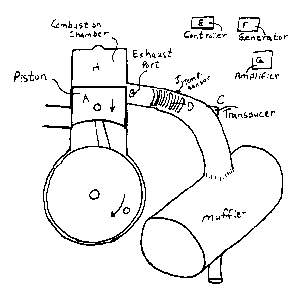Some of the information on this Web page has been provided by external sources. The Government of Canada is not responsible for the accuracy, reliability or currency of the information supplied by external sources. Users wishing to rely upon this information should consult directly with the source of the information. Content provided by external sources is not subject to official languages, privacy and accessibility requirements.
Any discrepancies in the text and image of the Claims and Abstract are due to differing posting times. Text of the Claims and Abstract are posted:
| (12) Patent Application: | (11) CA 2220858 |
|---|---|
| (54) English Title: | A PRECISE, CONTROLLED EXHAUST/INTAKE SYSTEM FOR THE INTERNAL COMBUSTION ENGINE |
| (54) French Title: | SYSTEME DE CONTROLE PRECIS D'ADMISSION/D'ECHAPPEMENT D'UN MOTEUR A COMBUSTION INTERNE |
| Status: | Deemed Abandoned and Beyond the Period of Reinstatement - Pending Response to Notice of Disregarded Communication |
| (51) International Patent Classification (IPC): |
|
|---|---|
| (72) Inventors : |
|
| (73) Owners : |
|
| (71) Applicants : |
|
| (74) Agent: | |
| (74) Associate agent: | |
| (45) Issued: | |
| (22) Filed Date: | 1998-01-19 |
| (41) Open to Public Inspection: | 1999-07-19 |
| Examination requested: | 1999-08-03 |
| Availability of licence: | N/A |
| Dedicated to the Public: | N/A |
| (25) Language of filing: | English |
| Patent Cooperation Treaty (PCT): | No |
|---|
| (30) Application Priority Data: | None |
|---|
This invention consists of the necessary parts such as a
transducer, amplifier, generator and accompanying sensors, hardware,
software to create a precisely timed sonic/sound wave/pulse capable of
compressing and influencing the movement of gasses within the confines
of an internal combustion engine - especially its exhaust/intake system.
Note: Claims are shown in the official language in which they were submitted.
Note: Descriptions are shown in the official language in which they were submitted.

2024-08-01:As part of the Next Generation Patents (NGP) transition, the Canadian Patents Database (CPD) now contains a more detailed Event History, which replicates the Event Log of our new back-office solution.
Please note that "Inactive:" events refers to events no longer in use in our new back-office solution.
For a clearer understanding of the status of the application/patent presented on this page, the site Disclaimer , as well as the definitions for Patent , Event History , Maintenance Fee and Payment History should be consulted.
| Description | Date |
|---|---|
| Inactive: IPC from MCD | 2006-03-12 |
| Application Not Reinstated by Deadline | 2003-12-08 |
| Inactive: Dead - No reply to s.30(2) Rules requisition | 2003-12-08 |
| Inactive: Abandoned - No reply to s.30(2) Rules requisition | 2002-12-09 |
| Inactive: S.30(2) Rules - Examiner requisition | 2002-06-07 |
| Inactive: Cover page published | 1999-10-06 |
| Letter Sent | 1999-08-17 |
| Inactive: Correspondence - Formalities | 1999-08-03 |
| Inactive: Compliance - Formalities: Resp. Rec'd | 1999-08-03 |
| Request for Examination Received | 1999-08-03 |
| All Requirements for Examination Determined Compliant | 1999-08-03 |
| Request for Examination Requirements Determined Compliant | 1999-08-03 |
| Application Published (Open to Public Inspection) | 1999-07-19 |
| Inactive: Incomplete | 1999-06-15 |
| Inactive: IPC assigned | 1998-03-21 |
| Inactive: IPC assigned | 1998-03-21 |
| Classification Modified | 1998-03-21 |
| Inactive: First IPC assigned | 1998-03-21 |
| Filing Requirements Determined Compliant | 1998-02-04 |
| Inactive: Filing certificate - No RFE (English) | 1998-02-04 |
| Application Received - Regular National | 1998-02-03 |
There is no abandonment history.
The last payment was received on 2002-12-23
Note : If the full payment has not been received on or before the date indicated, a further fee may be required which may be one of the following
Please refer to the CIPO Patent Fees web page to see all current fee amounts.
| Fee Type | Anniversary Year | Due Date | Paid Date |
|---|---|---|---|
| Application fee - small | 1998-01-19 | ||
| Request for examination - small | 1999-08-03 | ||
| 1999-08-03 | |||
| MF (application, 2nd anniv.) - small | 02 | 2000-01-19 | 1999-12-06 |
| MF (application, 3rd anniv.) - small | 03 | 2001-01-19 | 2000-12-01 |
| MF (application, 4th anniv.) - small | 04 | 2002-01-21 | 2002-01-15 |
| MF (application, 5th anniv.) - small | 05 | 2003-01-20 | 2002-12-23 |
Note: Records showing the ownership history in alphabetical order.
| Current Owners on Record |
|---|
| LLOYD TAYLOR |
| Past Owners on Record |
|---|
| None |